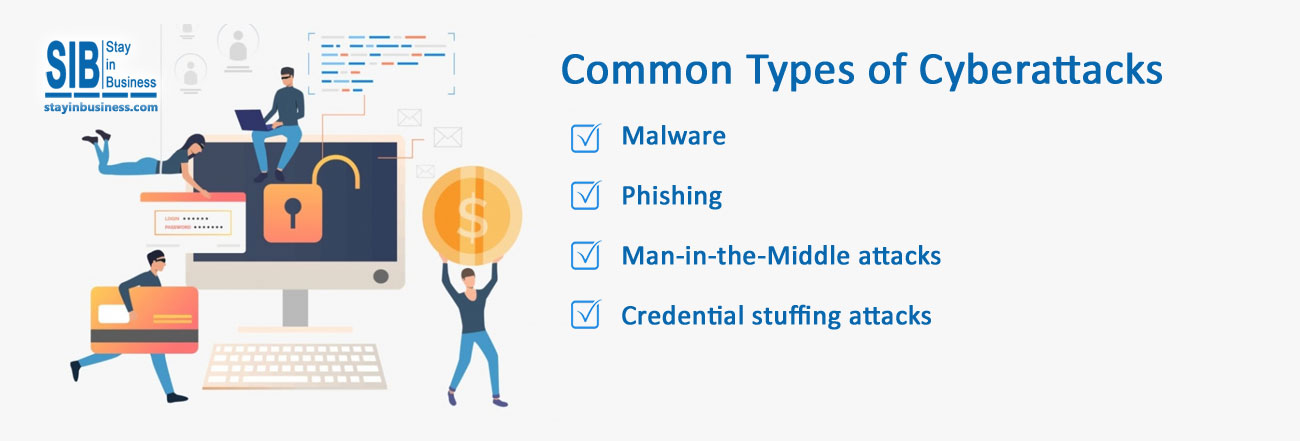
Cybersecurity tips for small businesses
With the growing change in technology and the high competition present, small businesses are also shifting to online platforms. Cybercriminals are a significant threat to businesses irrespective of the size. According to a 2020 report, 43 percent of cybercriminals target small businesses. This statistic shows that small businesses are becoming attractive targets for cybercriminals. Several attackers know that small are a rich source to steal information and hence target them.
What is a cyberattack?
A cyberattack involves an unauthorized attempt to access data. This could be done to expose or destroy data. Common types of cyberattacks are:
Malware
Malware (malicious software) comprises several types of attacks, including spyware, viruses, Trojan, adware, and computer worms. It consists of programs built to damage computers and computer systems.
Phishing
Phishing deceives victims and makes them share crucial data including passwords and credit card information. The victim may also be tricked to download a file by clicking on an email’s link. The scammers would send fraudulent messages that will give the picture of sending from a reputed company.
Man-in-the-Middle attacks
This type of attack occurs when scammers intercept communication between two parties without their knowledge. This is done to steal login credentials or any other sensitive details. The best example of Man-in-the-Middle attacks is free Wi-Fi hot spots.
Credential stuffing attacks
This type of attack is increasing because several users use the same password for multiple accounts. Attackers gather a vast number of leaked or stolen login credentials for the purpose of gaining unauthorized access to several accounts.
How small businesses can safeguard themselves from cyberattacks?
Several small business owners think they are not so big in their operations to fall prey to cyberattacks. However, hackers are always waiting for places that let their guard down. The challenge for small businesses lies in being smart enough in fighting cyberattacks. The following best practices will be helpful for small businesses to address cyberattacks effectively.
Become aware of cybersecurity
A significant mistake that small businesses do is to assume cyberattacks won’t target them. This leads to them being indifferent to cyberattacks and not providing training to employees. Undeniably, employees are the first line of defence regarding securing the network. Making employees aware of suspicious emails and encouraging them to report when something unusual happens is a good practice. They should not have the wrong idea that cybersecurity is out of their scope.
Develop a cybersecurity plan
With a cybersecurity plan in place, small businesses can detect threats soon and eventually respond proactively. All employees should have a sound comprehension of the internet and a fair knowledge of what falls under the cybersecurity.
Create passwords intelligently
A password must comprise at least eight characters in length. That said, the longer is an intelligent approach. Length plays a major role in a strong password compared to its complexity. Build passwords that don’t consist of names and dates of birth, and don’t reuse passwords across multiple accounts. The key is in using passwords that someone finds it difficult to guess. Use two-factor authentication, which provides an additional layer of security.
Enhance email security
For the past five decades, emails have revolutionized the way people communicate. For organizations it acts as a critical component to share information. Small businesses can train employees in not opening suspicious attachments or links.
Protect the organization’s Wi-Fi network
Wireless networks are known for their quick installment and ease of use. Thus they are increasingly used by small businesses. Unfortunately, Wi-Fis can be a major threat to a small business’ security if not secured appropriately. One best practice is to change the manufacturer’s default name to a unique name while configuring the router. Besides, enabling certain features in router settings because firewall protection is not automatically activated every time will secure the business’ network.
Install firewalls
A firewall is a digital protector that does not allow malicious software to access a network. Rather than relying only on anti-virus software, small businesses should have a firewall in place. A basic default firewall is not mostly sufficient to address cyberattacks. Here arises the need for small businesses to gain understanding of configuring firewalls correctly.
Use encryption
Encryption is an efficient way to protect sensitive data, including financial and business information and personal details. Organizations should ensure to encrypt all their resources, including computers, smartphones and tablets. Although cybercriminals get access to an organization’s data, it will not be of any use to them if the data is encrypted.
Small businesses may not have time and resources to look into evolving cybersecurity needs. The planning and prevention aspect can be consulted with external consultants. Stayinbusiness offers a business continuity plan for small businesses along with good practices in cybersecurity by keeping in mind that these businesses are not as prepared as large businesses to mitigate cyberattacks. After making an impact analysis, stayinbusiness provides a well-devised cybersecurity plan.
Are you ready for a disaster? If not find out how Stay In Business can help your business!




